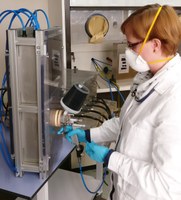NARILIS researchers report nanoparticles in spray paintings to be non-toxic
Through the NanoGeCo project, NARILIS researchers address the potential human safety issues linked to the application of nanomaterials to spray painting. This painting technique, which uses a device to spray a coating through the air onto a surface, produces a high percentage of paint overspray (aerosol). Inhalation is therefore the major route of exposure. The goal of the NanoGeCo project is to better characterize nanomaterial release during spray application and to evaluate the potential effects of airborne nanoparticles on the human health, in particular on the deep lungs.
NanoGeCo is a joint transnational project, coordinated by the UNamur (Dr. Julie Laloy, Pharmacy Department; Prof. Jean-Michel Dogné, Pharmacy Department & Prof. Stéphane Lucas, Physics of Matter and Radiation) and conducted in partnership with the Graz University of Technology (Austria), the Fraunhofer Institute for Manufacturing Engineering and Automation (Germany) and the Belgian painting company Dothée S.A. The NanoGeCo project is supported by the Walloon Region and the European programme SINN ERA-NET.
Ongoing since 2015, the NanoGeCo project provides new experimental data (particle size distribution and concentration in the paint overspray - nano and sub-micron size) from different aerosol measuring techniques and analyses of the chemical substances in paint aerosols. In parrallel, toxicological studies were performed using a rodent whole body exposure model. The results from these studies reveal that the generated nanoparticles in paint overspray would not be toxic.
Contact: Dr. Julie Laloy, project coordinator
+32 (0)81 72 43 35
nanogeco@unamur.be
NanoGeco website
 NAmur Research Institute for LIfe Sciences
NAmur Research Institute for LIfe Sciences


